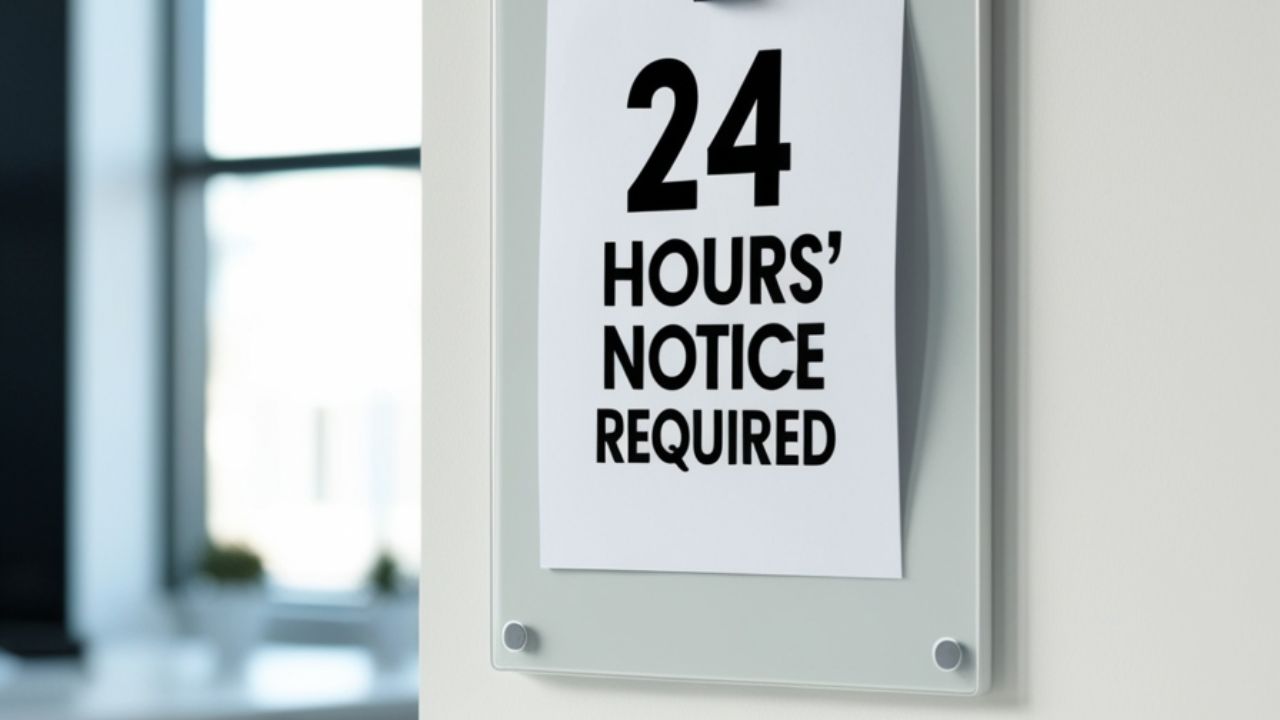When you write 24 hours’ notice, it shows ownership by time. The 24 hours own the notice. Using the right apostrophe makes your writing neat and professional. It helps others trust your words, especially in letters, school work, and documents.
People often forget the little mark that changes meaning. Writing 24 hour’s notice or 24 hours notice looks wrong. A small apostrophe keeps your sentence correct and clear. Learning this early helps you write better and sound smarter every day.
Many teachers, writers, and offices use 24 hours’ notice to keep grammar strong. It’s like putting a key in the right lock—it fits perfectly. Once you remember where that apostrophe goes, you’ll always make your writing look right and confident.
Why This Phrase Matters in Everyday and Professional English
Using 24 hours’ notice shows good grammar and clear writing. It helps people understand your message easily. When you use the right words, your work looks careful and correct. It makes teachers, friends, or coworkers see you as smart and responsible.
In offices, schools, or letters, writing 24 hours’ notice keeps things neat and professional. A small mark like an apostrophe changes meaning. Good writing builds trust and respect. It helps everyone follow rules and share messages without mistakes or confusion.
A Quick Primer on Apostrophes in English Time Expressions
| Expression | Type | Possessive? | Correct? |
| 24 hours notice | Plural noun | NO | No |
| 24 hour’s notice | Singular possessive | No | No |
| 24 hours’ notice | Plural possessive | Yes | Yes |
- Apostrophes show ownership — they tell us that time owns something, like in 24 hours’ notice or a day’s rest.
- Use ’s for singular time — write one day’s leave or an hour’s delay when talking about one unit of time.
- Add only ’ after plural time — write two weeks’ pay or 24 hours’ notice when more than one unit of time owns the noun.
- Do not use apostrophes for plurals — words like days or hours alone never need an apostrophe.
- Keep meaning clear — the apostrophe helps readers see how much time is connected to the action or object.
Breaking Down the Three Options

“24 Hours Notice” – Missing the Apostrophe
When someone writes 24 hours notice, it misses an important mark. The missing apostrophe makes the sentence look wrong. It changes meaning and shows carelessness. In school or office work, such small mistakes can make your writing look weak or unfinished.
Using the correct form helps every sentence sound right. Without the apostrophe, 24 hours notice seems unclear. It confuses readers and spoils the message. Adding that small sign shows care, skill, and respect for proper English writing rules.
“24 Hour’s Notice” – Singular Possessive Error
Writing 24 hour’s notice is not correct because it means only one hour owns the notice. This form changes the true meaning. It shows poor understanding of grammar rules and makes written work look careless or confusing to the reader.
The right form uses a plural word with an apostrophe after the “s.” Using 24 hour’s notice in papers or letters can cause mistakes. Correct writing shows good learning habits and helps others clearly understand your message every time.
See also A Chip off the Old Block: Meaning & Origin Explained
“24 Hours’ Notice” – The Correct Form
The phrase 24 hours’ notice is correct because it shows that the time owns the notice. The apostrophe after “s” makes the meaning clear. This small mark helps readers understand your writing quickly and keeps every sentence neat and proper.
When you write 24 hours’ notice, it follows the true grammar rule for showing possession. It is used in offices, schools, and legal papers. This simple rule builds good writing habits and helps you sound clear, smart, and professional.
- The phrase 24 hours’ notice shows that time owns the notice, so the apostrophe comes after s.
- It follows the plural possessive rule, which keeps grammar neat and clear.
- The mark helps readers understand that the full day controls the notice period.
- This form appears in offices, schools, and legal documents to keep writing formal.
- Using 24 hours’ notice correctly shows good learning, care, and professionalism.
The Grammar Behind Time-Based Possession
Historical Usage and Evolution in English
In old English writing, people used phrases like 24 hours’ notice to show time owning something. Long ago, writers used forms such as “a day’s work” or “a week’s rest.” These forms helped readers know how much time was connected to each action.
As English grew, grammar rules stayed similar. The idea of adding an apostrophe to show ownership never changed. Writers today still use 24 hours’ notice to keep that clear meaning. It shows the time controls or gives the notice, just like in older English.
Grammar Rules That Apply Here
- Add ’s for singular ownership, like a day’s work or an hour’s rest.
- Add only ’ for plural ownership, like two weeks’ pay or 24 hours’ notice.
- Never use an apostrophe to make a word plural.
- Use an apostrophe when time or quantity owns another word.
- Always check meaning — the apostrophe shows possession, not number.
Common Errors and Why They Happen
Misunderstanding Singular vs. Plural Possessives
Confusion often stems from forms we learned early on: “a day’s work.” We generalize that to “hours’,” forgetting that apostrophes follow plurals when showing possession.
Influence of Spoken Language and Typing Shortcuts
In old English writing, people used phrases like 24 hours’ notice to show time owning something. Long ago, writers used forms such as “a day’s work” or “a week’s rest.” These forms helped readers know how much time was connected to each action.
As English grew, grammar rules stayed similar. The idea of adding an apostrophe to show ownership never changed. Writers today still use 24 hours’ notice to keep that clear meaning. It shows the time controls or gives the notice, just like in older English.
Professional and Style Guide Perspectives
What Do Experts Say?
- Grammar experts agree that 24 hours’ notice is the right form because it shows plural possession.
- The Chicago Manual of Style supports using an apostrophe for time expressions showing ownership.
- The AP Stylebook suggests using 24-hour with a hyphen only when it acts as an adjective.
- The APA Style Guide follows the same rule, keeping 24 hours’ notice for formal or legal writing.
- Linguists explain that the apostrophe adds precision, keeping professional and academic writing correct.
Industry-Specific Preferences
- The legal field always uses 24 hours’ notice in contracts and formal letters for accuracy.
- HR departments prefer 24-hour notice when describing policies or schedules as adjectives.
- Marketing teams sometimes skip the apostrophe, but careful writers keep it for correctness.
- Academic writing follows strict grammar rules, using apostrophes for possessive time expressions.
- Corporate communication values clear, polished language, so 24 hours’ notice remains the trusted form.
Best Practices for Writers and Professionals
When to Always Use “24 Hours’ Notice”
- Use 24 hours’ notice in job resignation letters to show professionalism and respect.
- Include it in rental or lease agreements when giving or receiving notice to move out.
- Write it in company policies that describe schedule or shift changes.
- Use it in official emails or letters when setting clear deadlines for actions.
- Add it in legal or business documents where accuracy and formal tone are important.
Avoiding Confusion in Digital Communication
- Always type 24 hours’ notice carefully, even in short messages or emails.
- Avoid skipping apostrophes, as small errors can change meaning.
- Use tools like grammar checkers to catch missing marks or spelling slips.
- Write slowly and reread before sending important messages online.
- Keep sentences short and clear so every reader understands your message easily.
Case Studies: Real-Life Mistakes and Fixes

Case Study 1: HR Memo Error
An office once sent an HR memo without the apostrophe in 24 hours’ notice. The message looked unclear, and many workers did not understand the rule. Some thought it meant only time, not a warning period, which caused small problems in planning.
Later, the HR team fixed the writing and added the missing mark. The corrected 24 hours’ notice helped everyone read and follow the rule easily. This small change improved clarity, reduced mistakes, and made the company’s communication more professional.
Case Study 2: Lease Agreement Revision
A rental paper once used the wrong form instead of 24 hours’ notice. The tenant became unsure about the rule and asked a lawyer to check it. The unclear line made both sides confused about the time needed before leaving the home.
The landlord later changed the document and used the correct 24 hours’ notice form. This small update made the meaning clear and fair. Both tenant and owner understood the rule better, and the agreement looked proper and professional again.
See also Polite vs Courteous: The Subtle Difference Explained
Case Study 3: Email Confusion in Tech Team
A manager once wrote an email without adding the apostrophe in 24 hours’ notice. The team misunderstood the message and thought they had extra time. The missing mark caused confusion and delayed the task that everyone needed to finish quickly.
Later, the manager corrected the writing and sent a new email. The right 24 hours’ notice helped the team understand clearly. The change improved teamwork, reduced mistakes, and showed how small grammar details can make a big difference in clear communication.
Final Word
Using 24 hours’ notice shows care, learning, and respect for proper English. The small apostrophe makes a big difference. It helps your message stay clear, polite, and correct in school work, letters, or any important writing shared with others.
Good grammar builds trust and confidence. When writers use 24 hours’ notice correctly, their words look neat and meaningful. This simple rule teaches the value of accuracy, making every message stronger, clearer, and more professional in daily life and work.
FAQs
Can I resign with 24 hours notice?
Yes, but it’s unprofessional. Most employers expect at least two weeks’ notice unless emergencies arise.
What happens if you give 24 hours notice?
You may lose goodwill or benefits; some employers might end your role immediately.
Do landlords need to give 24 hours notice?
Yes, in most regions, landlords must give tenants at least 24 hours’ notice before entering a property.
How to write a 24 hours notice?
State your intent clearly, include the date and reason, and thank your employer or landlord politely.

Join Bibcia on a journey to master English grammar. Discover easy lessons, writing tips, and practical examples designed to make learning grammar simple and effective.










